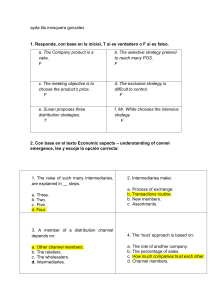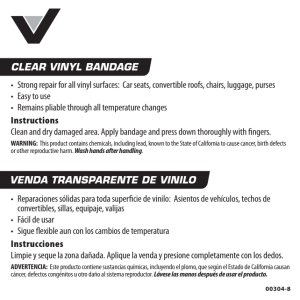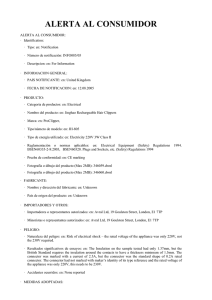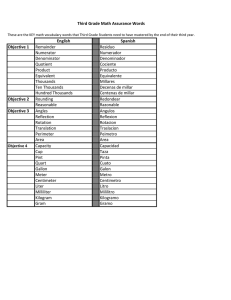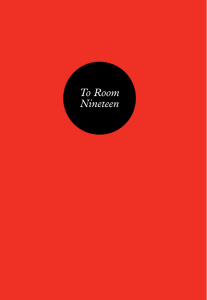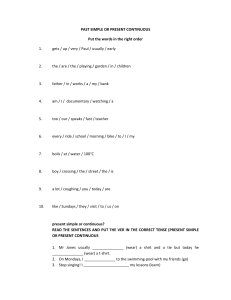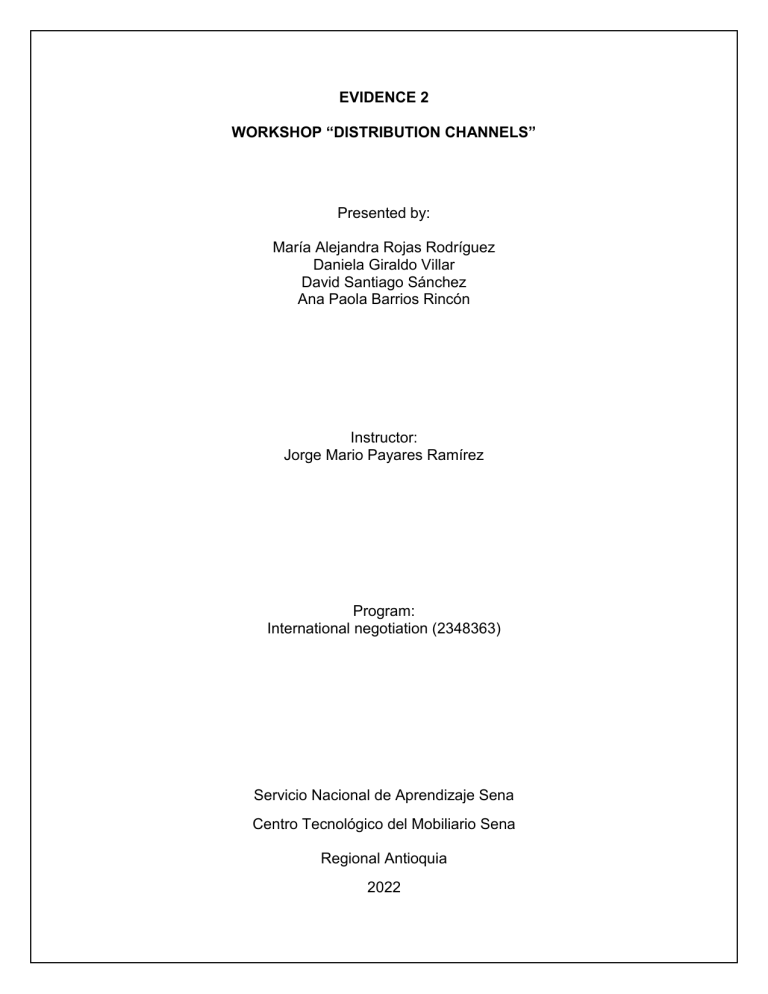
EVIDENCE 2 WORKSHOP “DISTRIBUTION CHANNELS” Presented by: María Alejandra Rojas Rodríguez Daniela Giraldo Villar David Santiago Sánchez Ana Paola Barrios Rincón Instructor: Jorge Mario Payares Ramírez Program: International negotiation (2348363) Servicio Nacional de Aprendizaje Sena Centro Tecnológico del Mobiliario Sena Regional Antioquia 2022 ACTIVIDAD DE APRENDIZAJE 4 Definir canal de distribución según el mercado y el tipo de producto. Evidencia 2: Workshop “Distribution channels” Conocer en qué consiste la selección de los canales de distribución y manejar este tema en el idioma inglés le permite ampliar el campo de acción hacia otros países de cualquier empresa que desee exportar un producto o servicio y con ello aumentar sus ingresos; en caso de contar con clientes o socios de habla inglesa. Por lo anterior y para desarrollar esta evidencia, consulte el material de formación denominado Distribution channels y los siguientes materiales complementarios: Vocabulary. English prepositions. EVIDENCE 2 Workshop “Distribution channels” 1. Lea cuidadosamente la siguiente conversación: Susan: Good morning Mr. White. Mr. White: Good morning, Ms. Susan. Can we start the meeting? Susan: Of course, Mr. White. I have the options on the board. Mr. White: That’s good. Remember, we need to choose the most suitable distribution strategy for our products. Susan: We have three strategies: Intensive, exclusive and selective. Intensive strategy pretends to reach the largest possible number of POS (Point of Sale), but unfortunately it’s difficult to control. That’s because we would have to deal with many intermediaries. Mr. White: What about the exclusive strategy? Susan: It’s different from the first one. Only it’s necessary one POS by each geographic area, no matter if it’s retailer or wholesaler. Mr. White: Sounds god to me. And the last one? Susan: Well, it’s the selective strategy. It’s the intermediate strategy between the other ones. Mr. White: I don’t know. I like the first one, but I don’t know how profitable it is. Hhhhmmm, well. What do you think? Susan: Well, I consider that the selective strategy is the best. Mr. White: You’re right. Well done. Susan: Thanks, Mr. White. 2. Responda T si es verdadero o F si es falso. a. The Company product is a cake. T ( ) F (X) b. The meeting objective is to choose the product’s price. T ( ) F (X) c. Susan proposes three distribution strategies. T (V) F ( ) d. The selective strategy pretend to reach many POS. T ( ) F (X) e. The exclusive strategy is difficult to control. T ( ) F (X) f. Mr. White chooses the intensive strategy. T ( ) F (X) 3. Lea el siguiente texto y responda las preguntas planteadas posteriormente: Economic aspects – understanding of cannel emergence Economic reasons are the foremost determinant of channel structure. The emergence of the wide variety of intermediaries can be explained in terms of four logically related steps in an economic process: Intermediaries can increase the efficiency of the process of exchange, • • • They align the quantities and assortments produced with the quantities and assortments consumed, They make transactions routine, and They facilitate the searching process. Dependence and cooperation Each member of a distribution channel is dependent upon the behaviour of other channel members. Four different approaches have been used to assess dependence levels in channel relationships: • • • • The ‘sales and profit’ approach, which postulates that the larger the percentage of sales and profit contributed by the source firm, the greater the target’s dependence on the source. The ‘role performance’ approach, which assesses the firm’s role performance in carrying out its role in relation to another company down or up the channel. The ‘specific assets –offsetting investment’ approach, which maintains that offsetting investments help to safeguard the target company against opportunism by the source. The ‘trust’ approach, in which a long-term relationship is built on the extent to which companies trust one another. Preguntas: 1. The raise of such many intermediaries, are explained in ___ steps. a. Three. b. Two. c. Five. d. Four. 2. Intermediaries make: a. Process of exchange. b. Transactions routine. c. New members. d. Assortments. 3. A member of a distribution channel depends on: a. Other channel members. b. The retailers. c. The wholesalers. d. Intermediaries. 4. The ‘trust’ approach is based on: a. The role of another company. b. The percentage of sales. c. How much companies trust each other. d. Channel members. 5. The ‘role performance’ approach assesses: a. The firm’s role performance. b. The other channel members’ behavior. c. Retailers. d. Wholesalers. 4. Describa en inglés un producto de su preferencia, asígnele una marca y presente, tanto las características como los costos de dicho producto, luego seleccione un canal y tipo de estrategia de distribución según la clase de producto. HASS AVOCADO Mark HASSGUACATE The Hass avocado or Hass avocado is a variety of the American Persea fruit, which originated from a seed of the Guatemalan race. The Hass variety has an oil content that ranges between 8 and 12%. In addition, the proportion of water is low, barely 60-70%. Its content of B vitamins and vitamin E is considerable. Characteristics Both the fruit and the seed are relatively small. With a joint weight between 200 to 300 g. The skin is somewhat leathery, rough, green to slightly blackish when on the tree; once harvested, it turns purple to black as the fruit softens when ripe, so the consumer recognizes the optimal time to consume it. The fruit is of excellent quality, without fiber, high resistance to transport and long postharvest life. Cost Distribution Channel Depending on its size and weight, it is $2,000, $3,000, $4,000 and $5,000 Wholesale distribution channel with which greater coverage is offered at a geographical level. This distribution channel also guarantees the alliance with distributors and wholesalers through distribution agreements where the parties agree to send a specific quantity and the distributor buys and distributes it, that is, it allows production to be planned in advance according to demand. At the same time as the presence of intermediaries, the costs are maintained and are lower. Type of distribution strategy Intensive distribution: the manufacturer seeks a greater number of points of sale for the placement of a product. The type of point of sale chosen does not matter, the important thing is that the product can be sold to the customer. On many occasions, this type of distribution loses brand image and prestige, in exchange for commercial coverage. Thanks.
